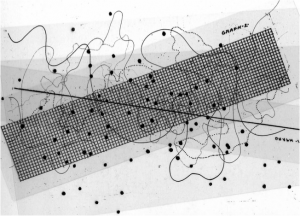John Cage was an American music composer that paved the way for randomness in music. Many of his musical compositions explored theories of chance through methods such as implementing deliberate randomness processes in their productions. He wanted to challenge the nature of what sounds we expect to hear by expanding his compositions to comprise of unforeseen/unintended elements of sound.

In the score of his “Fontana Mix,” we will find 10 pages of paper and 12 transparencies of graphic notation of music with text made up of various languages and individual letters, 12 different lines of different colors, and 16 black squares representing different vocal sounds of different singing styles. Cage uses wavy/curvy lines with varying texture and thickness to indicate the different sounds within the mix. I admire John Cage’s work because he created a chance system to render unfixed compositional techniques (like an algorithm for indeterminacy) to utilize chance into his musical compositions.
“Fontana Mix” by John Cage (1958)
![[OLD FALL 2018] 15-104 • Introduction to Computing for Creative Practice](wp-content/uploads/2020/08/stop-banner.png)